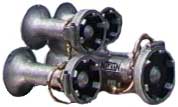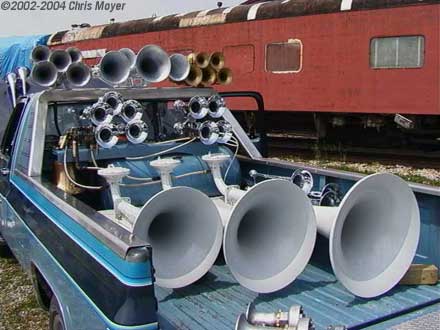This web site is my contribution to the diesel air horn hobby. I have been involved with this hobby for quite awhile now, and have always had an interest in trains as far as I can remember. Growing up a quarter mile from a railroad has given me the opportunity to see and experience the down-home charm that only a shortline railroad can provide. I have since stepped up and work with the railroad I grew up around, letting me live out one of my dreams! Since this is not my real source of income, this also gives me the flexibility to really enjoy the work, too. I'm qualified as a trainman, brakeman, conductor, and engineer on our passenger and freight trains, and I also mentor many of the "younger" railroaders.
 My interest in diesel air horns started early in my life.
As a young kid, I would always listen to the sounds of trains, with a special ear towards the horns and whistles they used, the "voices" of the iron horses.
Whereas others would just hear a train, I would know which locomotive was running on our shortline.
For the larger, class 1 railroads, I knew that each railroad typically had a different horn they preferred to use, as well.
I'm sure my background in school music, particularly brass instruments, helped me along, too.
I know it has helped me quite a bit since, allowing me to distinguish horn chords, how close to in-tune they are, and the theory behind it all.
My interest in diesel air horns started early in my life.
As a young kid, I would always listen to the sounds of trains, with a special ear towards the horns and whistles they used, the "voices" of the iron horses.
Whereas others would just hear a train, I would know which locomotive was running on our shortline.
For the larger, class 1 railroads, I knew that each railroad typically had a different horn they preferred to use, as well.
I'm sure my background in school music, particularly brass instruments, helped me along, too.
I know it has helped me quite a bit since, allowing me to distinguish horn chords, how close to in-tune they are, and the theory behind it all.
However, it wasn't until I was in college, and just after I started working for the railroad, that I started to dig into this hobby, starting with a #1 K bell. I was trying to copy what I would later find out was a Leslie A-200 (and funny enough I've still never owned one!). After aquiring the horn and doing a little research, I stumbled across the 5 Chime Consultants web site, which opened me up to just how many different horns exist. From there, I found Brent Lee's TrainHorns Yahoo group, and got my first complete horn, a second-generation, old-casting P5, which I still have to this day. Next came a Prime 920, a Westinghouse E-2, and a NJ Transit AA-2, and it's been "downhill" ever since! My first horn honk was one of Rodger Granlund's Altoona horn honks, held right in downtown Altoona. I met some great people like Jeff, Elwood, Fred, Ed, and many more. I also found people who collected steam whistles, which I've also delved into over time.
One quick rant - Diesel air horns put on a truck or other road vehicle can be a bad idea. These horns were intended and designed for use on a diesel locomotive. Train horns are extremely loud, and it is against the law to blow them while driving down the road in some places. In my opinion, using horns to scare people is childish and stupid, and gives all legitimate horn collectors a bad name. Please use some common sense if you are considering placing a set of train horns on a road vehicle, and think twice about why you want to do this. I am not against placing horns on a vehicle as long as they are used responsibly. There are many great examples of "appropriate" uses of horns on vehicles - which do not include scare tactics - and the responsible owners that go with them.

Much of the information organized in this site was learned from other collectors, the TrainHorns and Horn/Whistle Yahoo groups, the Locomotive Air Horns message board, and the Horn & Whistle Journal. Many thanks to everyone - Elwood Belknap, Fred Berry, Doc Bryant, Ron Chamberlain, Steve Forrest, Jeff Hammaker, Ken Kanne, Ed Kaspriske, Ken Lanovich, Brent Lee, and Mike Muha to name a few - who have been so open in sharing their knowledge and experiences so far! I know I've missed some... there are far too many great people in this hobby!!
Please note that all photos and multimedia contained on these pages, if not stated otherwise, are copyrighted. DO NOT reproduce anything without consent first of the copyright holder; "Reproduction without the consent of the copyright holder is punishable by law." There is also some media contained herein for which the creator is unknown, and is noted as such. This media was found in public domain, and is assumed to be available for public use; I do not make any profit with this site. If there is anything which appears here and is copyrighted without proper credit, please e-mail me so I can either give proper credit or remove the work. The remainder of these pages and all their contents are copyrighted 2004 LocomotiveHorns.info and Chris Moyer.
© 2001, 2004, 2025 LocomotiveHorns.info, Chris Moyer